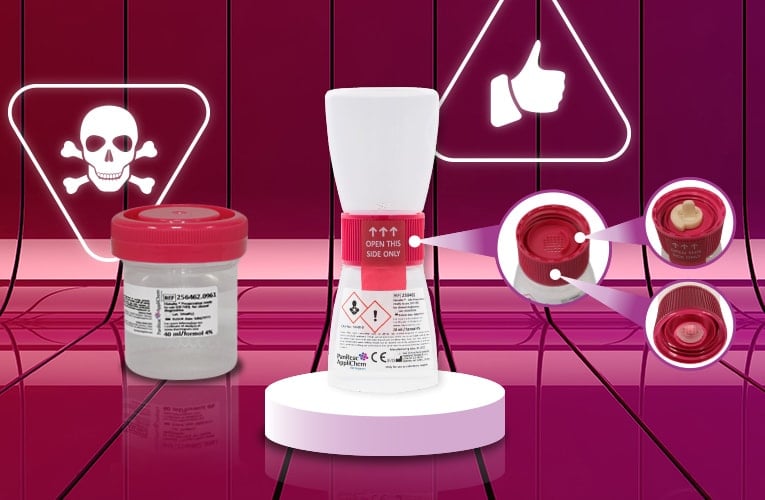Histofix®-Safe 30 ml (50 PCS)
Histofix®-Safe 30 ml (50 PCS)
Couldn't load pickup availability
Patented by ITW Reagents, this innovative closed-loop safety device for the secure fixation and transportation of small histological specimens prevents user exposure to carcinogenic formaldehyde solution and ensures safe and convenient handling of biopsies by healthcare professionals.
Histofix®-Safe: Innovative Solution for Safe and Comfortable Biopsy Handling
The Histofix®-Safe system from PanReac AppliChem ITW Reagents is a state-of-the-art container for the safe handling and fixation of biopsies in clinical diagnostics. It is specifically designed to protect medical professionals from exposure to the carcinogenic formaldehyde solution commonly used in pathology and histology. Formaldehyde can pose significant health risks with regular contact, including respiratory irritation, allergic skin reactions and an increased risk of tumours in the nasal and throat areas. With its closed-loop system, Histofix®-Safe minimises the risk of fumes and droplets escaping, which can occur with similar systems, protecting against inhalation and skin contact.
A bidirectional valve enables the safe transfer of formaldehyde solution from the filled to the empty container without releasing fumes. The integrated grid with safety cap ensures that even sticky samples can be placed and removed safely without contact with formalin. In compliance with Regulation (EU) 2017/746 on in-vitro diagnostic medical devices (IVDR), Histofix®-Safe offers maximum reliability and safety. Available in various sizes, this innovative system combines optimal protection with ease of use, making it an indispensable tool for safe and efficient biopsy processing.
Key Features
Histofix®-Safe state-of-the-art container for biopsies
Ready-to-use preservative for clinical diagnostics
Contains 4% buffered, methanol-stabilized formalin
Safe and convenient handling of tissue samples by medical professionals
Closed-loop system for fixation and transport of small histological specimens
Protects the user from exposure to carcinogenic formaldehyde solution
Complies with Regulation (EU) 2017/746 on in-vitro diagnostic medical devices (IVDR)
Offers superior advantages over comparable systems thanks to the bi-directional valve
Formaldehyde is transferred from the filled container to the empty container with the sample under pressure
Grid with safety cap ensures the absence of fumes
Grid allows safe placement and removal of sticky samples without formalin contact
Optimal combination of workplace protection and ease of use
Excluded from the right to return
Available in different sizes
Formaldehyde - A Toxic Substance in Everyday Medical Use
Formaldehyde is a colourless, pungent-smelling gas that is present in aqueous solution as formaldehyde solution. Due to its disinfectant and preservative properties, it is commonly used in the medical field, particularly for fixing tissue samples. Despite its usefulness, formaldehyde poses significant health risks to medical professionals.
Even at low concentrations, formaldehyde can irritate the mucous membranes of the eyes and airways, leading to symptoms such as burning eyes, sore throat, and coughing. Repeated skin contact with formaldehyde can also cause allergic reactions, including rashes and dermatitis. Some individuals may develop a sensitisation that causes intensified reactions upon further exposure. Formaldehyde is classified as carcinogenic to humans. Chronic exposure often leads to inflammation, which serves as a breeding ground for cancer cell development. Tumours can develop, especially in the nasal and throat area, where formaldehyde is most concentrated in the air.
Medical professionals who regularly work with formaldehyde solution – such as in pathology or during sample collection in practices – are at increased risk. Inhalation of formaldehyde is particularly dangerous, as even low concentrations can irritate the airways and have long-term carcinogenic effects.
Share




